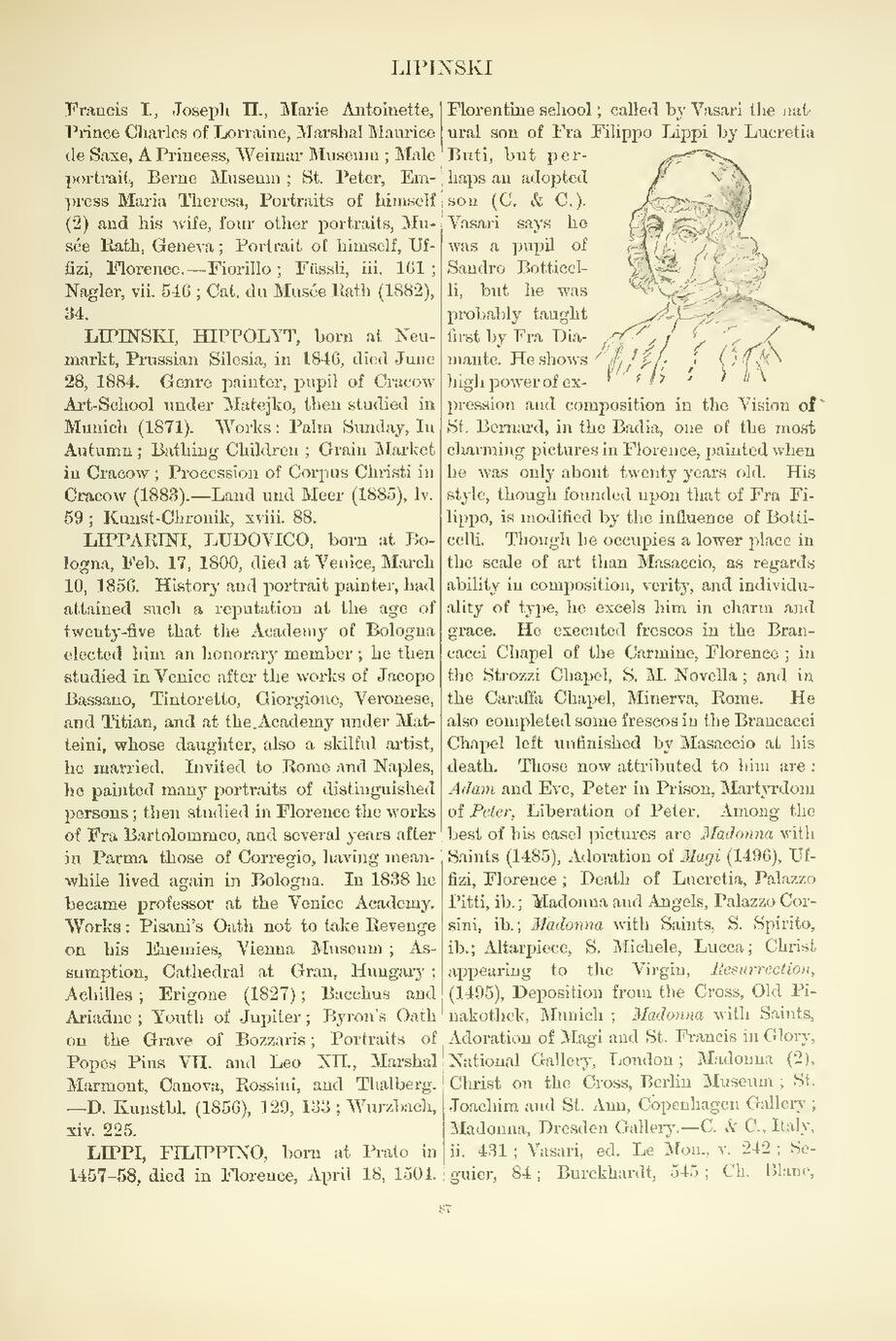Francis I., Joseph II., Marie Antoinette, Prince Charles of Lorraine, Marshal Maurice de Saxe, A Princess, Weimar Museum; Male portrait, Berne Museum; St. Peter, Empress Maria Theresa, Portraits of himself (2) and his wife, four other portraits, Musée Rath, Geneva; Portrait of himself, Uffizi, Florence.—Fiorillo; Füssli, iii. 161; Nagler, vii. 546; Cat. du Musée Rath (1882), 34.
LIPINSKI, HIPPOLYT, born at Neumarkt,
Prussian Silesia, in 1846, died June
28, 1884. Genre painter, pupil of Cracow
Art-School under Matejko, then studied in
Munich (1871). Works: Palm Sunday, In
Autumn; Bathing Children; Grain Market
in Cracow; Procession of Corpus Christi in
Cracow (1883).—Land und Meer (1885), lv.
59; Kunst-Chronik, xviii. 88.
LIPPARINI, LUDOVICO, born at Bologna,
Feb. 17, 1800, died at Venice, March
10, 1856. History and portrait painter, had
attained such a reputation at the age of
twenty-five that the Academy of Bologna
elected him an honorary member; he then
studied in Venice after the works of Jacopo
Bassano, Tintoretto, Giorgione, Veronese,
and Titian, and at the Academy under Matteini,
whose daughter, also a skilful artist,
he married. Invited to Rome and Naples,
he painted many portraits of distinguished
persons; then studied in Florence the works
of Fra Bartolommeo, and several years after
in Parma those of Corregio, having meanwhile
lived again in Bologna. In 1838 he
became professor at the Venice Academy.
Works: Pisani's Oath not to take Revenge
on his Enemies, Vienna Museum; Assumption,
Cathedral at Gran, Hungary;
Achilles; Erigone (1827); Bacchus and
Ariadne; Youth of Jupiter; Byron's Oath
on the Grave of Bozzaris; Portraits of
Popes Pius VII. and Leo XII., Marshal
Marmont, Canova, Rossini, and Thalberg.—D.
Kunstbl. (1856), 129, 133; Wurzbach,
xiv. 225.
An image should appear at this position in the text. To use the entire page scan as a placeholder, edit this page and replace "{{missing image}}" with "{{raw image|Cyclopedia of painters and paintings (IA cyclopediaofpain03cham).pdf/109}}". Otherwise, if you are able to provide the image then please do so. For guidance, see Wikisource:Image guidelines and Help:Adding images. |
LIPPI, FILIPPINO, born at Prato in
1457-58, died in Florence, April 18, 1504.
Florentine school; called by Vasari the natural
son of Fra Filippo Lippi by Lucretia
Buti, but perhaps
an adopted
son (C. & C.).
Vasari says he
was a pupil of
Sandro Botticelli,
but he was
probably taught
first by Fra Diamante.
He shows
high power of expression
and composition in the Vision of
St. Bernard, in the Badia, one of the most
charming pictures in Florence, painted when
he was only about twenty years old. His
style, though founded upon that of Fra Filippo,
is modified by the influence of Botticelli.
Though he occupies a lower place in
the scale of art than Masaccio, as regards
ability in composition, verity, and individuality
of type, he excels him in charm and
grace. He executed frescos in the Brancacci
Chapel of the Carmine, Florence; in
the Strozzi Chapel, S. M. Novella; and in
the Caraffa Chapel, Minerva, Rome. He
also completed some frescos in the Brancacci
Chapel left unfinished by Masaccio at his
death. Those now attributed to him are:
Adam and Eve, Peter in Prison, Martyrdom
of Peter, Liberation of Peter. Among the
best of his easel pictures are Madonna with
Saints (1485), Adoration of Magi (1496), Uffizi,
Florence; Death of Lucretia, Palazzo
Pitti, ib.; Madonna and Angels, Palazzo Corsini,
ib.; Madonna with Saints, S. Spirito,
ib.; Altarpiece, S. Michele, Lucca; Christ
appearing to the Virgin, Resurrection,
(1495), Deposition from the Cross, Old Pinakothek,
Munich; Madonna with Saints,
Adoration of Magi and St. Francis in Glory,
National Gallery, London; Madonna (2),
Christ on the Cross, Berlin Museum; St.
Joachim and St. Ann, Copenhagen Gallery;
Madonna, Dresden Gallery.—C. & C., Italy,
ii. 431; Vasari, ed. Le Mon., v. 242; Seguier,
84; Burckhardt, 545; Ch. Blanc,
